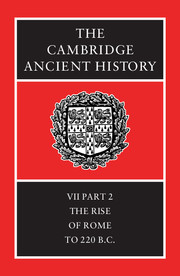Book contents
- Frontmatter
- 1 The Sources for Early Roman History
- 2 Archaic Rome Between Latium and Etruria
- 3 The origins of Rome
- 4 Rome in the fifth century I: the social and economic framework
- 5 Rome in the fifth century II: the citizen community
- 6 Rome and Latium to 390 B.C.
- 7 The recovery of Rome
- 8 The conquest of Italy
- 9 Rome and Italy in the early third century
- 10 Pyrrhus
- 11 Carthage and Rome
- 12 Religion in Republican Rome
- Appendix
- Chronological Table
- BIBLIOGRAPHY
- Index
- Fig. 50:The city of Rome in the early third century b.c.
- Map 11: The western Mediterranean in the third century
- References
1 - The Sources for Early Roman History
Published online by Cambridge University Press: 28 March 2008
- Frontmatter
- 1 The Sources for Early Roman History
- 2 Archaic Rome Between Latium and Etruria
- 3 The origins of Rome
- 4 Rome in the fifth century I: the social and economic framework
- 5 Rome in the fifth century II: the citizen community
- 6 Rome and Latium to 390 B.C.
- 7 The recovery of Rome
- 8 The conquest of Italy
- 9 Rome and Italy in the early third century
- 10 Pyrrhus
- 11 Carthage and Rome
- 12 Religion in Republican Rome
- Appendix
- Chronological Table
- BIBLIOGRAPHY
- Index
- Fig. 50:The city of Rome in the early third century b.c.
- Map 11: The western Mediterranean in the third century
- References
Summary
The first section of this chapter deals with the main literary and archaeological sources for early Roman history. The second considers the type of material which was at the disposal of the historians of Rome for the regal period and the fifth century and how they used it.
THE SURVIVING EVIDENCE
(a) Literary sources
There were three, possibly four, main historical strands – Greek, Roman, Etruscan and Carthaginian. The Carthaginian can be discounted, because, although probably used at second-hand by the Greek historian Polybius, nothing survives or can be recovered independently. The Emperor Claudius in a famous speech preserved at Lyons (ILS 212) refers to ‘Tuscan authors’ (‘auctores… Tuscos’) in connexion with the legend of Mastarna and the Vibennae (see p. 94f). There are a few other references to Etruscan historians and Claudius’ account is strikingly corroborated by frescoes from the François tomb at the Etruscan city of Vulci. Nevertheless, there is no evidence for Etruscan writers who were active in the fifth or fourth century. Claudius’ ‘Tuscan authors’ were learned scholars with an Etruscan background, like A. Caecina, writing in the first century B.C. We cannot reconstruct their work or judge how reliable it was.
The Greeks, on the other hand, knew about Rome from an early date. Aristotle was aware of the capture of Rome by the Gauls in 390 B.C., and a series of minor historians interested themselves in the foundation legends of the city. One or two early Greek writers are of considerable importance even though their works do not survive. Imbedded in the history of Dionysius of Halicarnassus (Ant. Rom. vn.3ff) is an extensive excursus about Aristodemus, the tyrant of Cumae, and his defeat of the Etruscan Porsenna near Aricia c. 504 B.C
Keywords
- Type
- Chapter
- Information
- The Cambridge Ancient History , pp. 1 - 29Publisher: Cambridge University PressPrint publication year: 1990
References
- 3
- Cited by



